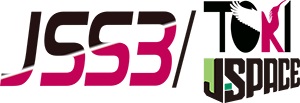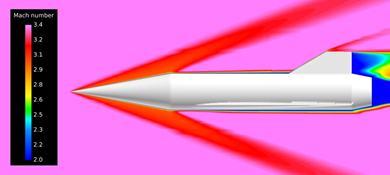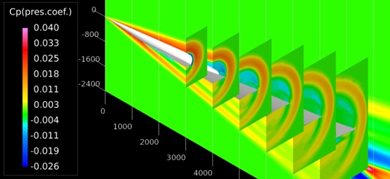Research on High Speed Propulsion Systems using Hydrogen Fuel
JAXA Supercomputer System Annual Report April 2016-March 2017
Report Number: R16E0022
- Responsible Representative: Hisao Futamura(Aeronautical Technology Directorate, Propulsion Research Unit)
- Contact Information: Hideyuki Taguchi(taguchi.hideyuki@jaxa.jp)
- Members: Motoyuki Hongoh, Masaharu Hiruma, Jun Butsuen
- Subject Category: Aviation(Aircraft engine)
Abstract
Research and development to establish technologies for a Mach 5 class hypersonic passenger aircraft that can cross the Pacific Ocean in 2 hours is being conducted. Hypersonic passenger aircraft flying at Mach 5 will be exposed to higher temperature environments than supersonic aircraft flying at around Mach 2. Therefore, research and development of a new engine and a heat-resistant structure are necessary. With the main focus on research and development of hypersonic turbojet engine that can operate continuously from takeoff to Mach 5, our R&D in this field also include system analysis of hypersonic passenger aircraft, aerodynamic design, heat resistance design, and other important features.
Goal
– To obtain maximum thrust of the hypersonic turbojet by operating the variable mechanisms as well as testing thrust control simulating actual flight by conducting an afterburner combustion test.
– To obtain control characteristics of the High-Mach Integrated Control Experimental Aircraft in order to establish an aircraft / propulsion integrated control system.
– To identify the required specifications of the hypersonic aircraft as well as to indicate the design specifications of the Hypersonic Cruise Experimental Aircraft for conducting a hypersonic cruise test.
Objective
To demonstrate thrust control method of a hypersonic turbojet with pre-cooler using liquid hydrogen fuel and aircraft / propulsion integrated control method, and present experimental / practical aircraft system in the future.
References and Links
N/A
Use of the Supercomputer
– The aerodynamic characteristics of the High-Mach Integrated Control Experiment Aircraft is validated utilizing CFD and compared to the wind tunnel test results.
– A conical wave-rider shape is applied as the wing of the Hypersonic Cruise Experimental Aircraft and CFD is performed to evaluate the improvement in aerodynamic characteristics.
Necessity of the Supercomputer
Since obtaining the aerodynamic characteristics of a hypersonic experimental aircraft utilizing CFD require intensive calculation and a long calculation time.
Achievements of the Year
– Aerodynamics of the High-Mach Integrated Control Experimental Aircraft is evaluated by CFD analyses and hypersonic wind tunnel tests.
– Hypersonic and low-speed aerodynamics of the Hypersonic Cruise Experimental Aircraft is evaluated by CFD analyses.
Publications
N/A
Computational Information
- Parallelization Methods: Hybrid Parallelization
- Process Parallelization Methods: MPI
- Thread Parallelization Methods: OpenMP,Automatic Parallelization
- Number of Processes: 60
- Number of Threads per Process: 12
- Number of Nodes Used: 5
- Elapsed Time per Case (Hours): 72
- Number of Cases: 70
Resources Used
Total Amount of Virtual Cost(Yen): 8,881,084
Breakdown List by Resources
| System Name | Amount of Core Time(core x hours) | Virtual Cost(Yen) |
|---|---|---|
| SORA-MA | 1,532,647.48 | 2,507,196 |
| SORA-PP | 671,729.33 | 5,735,224 |
| SORA-LM | 2,497.20 | 56,187 |
| SORA-TPP | 0.00 | 0 |
| File System Name | Storage assigned(GiB) | Virtual Cost(Yen) |
|---|---|---|
| /home | 1,201.63 | 11,335 |
| /data | 53,710.96 | 506,657 |
| /ltmp | 6,835.94 | 64,483 |
| Archiving System Name | Storage used(TiB) | Virtual Cost(Yen) |
|---|---|---|
| J-SPACE | 0.00 | 0 |
Note: Virtual Cost=amount of cost, using the unit price list of JAXA Facility Utilization program(2016)
JAXA Supercomputer System Annual Report April 2016-March 2017




